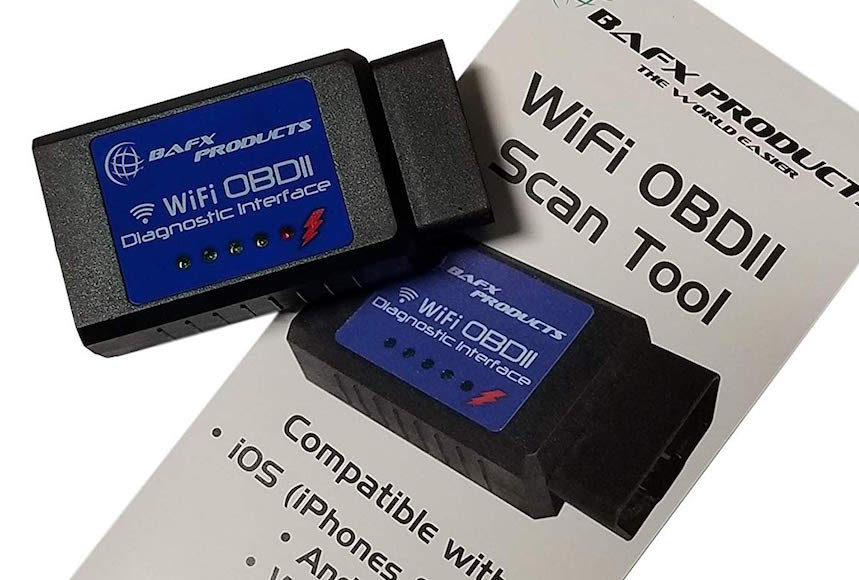Is your Honda CR-V years 2002 to 2007 acting slow to start or not starting sometimes? Well, I just had this happen to me and let me walk through some good tips and tricks and how to figure out fast what is going wrong.
First things first. Make sure your battery is actually charged up and the connections are clean and tight. You would be surprised how often this is the problem. A general rule of thumb is if you can grab the positive or negative terminal on your battery and get it to wiggle loose by simply pulling or pushing on it (with some effort) then it is too loose.
Get it to seat all the way down on the terminal, and make sure it is clean. Any amount of corrosion likely will cause more resistance in the circuit and a potential no start or slow cranking problem.
But, what happens or what should you do if your battery is totally charged, a jumpstart doesn’t help, and your Honda CR-V isn’t starting or won’t start sometimes.
This can be a confusing problem for sure, but these cars are known for one item going bad which can cause these symptoms.
On Honda’s 2002-2007 most intermittent no start conditions or a slow cranking sound that doesn’t go away with a jumpstart are due to a bad or dying starter motor. Be sure to check for starter relay engaging when you turn the key to the start position, then check for power at the starter and good connections, then likely you will need to be replacing the starter.
Table of Contents
Diagnosing Bad Starter:
- Turn the key to the “Start” position. Does the starter engage? If it doesn’t do you hear a relay clicking under the hood? It is best if you have a helper keep trying to start the car while you listen or feel for the relay clicking under the hood. IF you hear the relay clicking then you know that the fuse is good, and the starter is LIKELY receiving power. It is always good to check the wire running to the starter that gives it 12v to tell it to crank over.
- If you can get access to the starter to check the 12v big connection that runs positive battery voltage to the starter. You should see battery voltage all the time.
- Have someone try to start the car while you check the smaller connection that sends a 12v signal when you turn the key to the start position.
- If your car is having an intermittent no start condition, and also a slow cranking sound when it does start– and the battery/connections are good, then you are likely dealing with a dying starter motor.
Replacing the Starter:
On a Honda CR-V from 2002-2007, the starter is located underneath the intake manifold. There are two very different schools of thought on how best to remove the starter.
Some people claim that by going from underneath the car it is easier. Others claim that going from the top and removing the intake manifold is the way to go and will save you a ton of time.
Having done this job myself on the ground on jack stands I can tell you, 100%, I would definitely take the intake manifold off and remove the starter from the top. Why? Because reaching the top 14mm bolt that is a “step-bolt” is a knucklebuster and extremely frustrating. With the exact right socket and breaker bar set up, you can get it loose, and then you battle getting it all the way off. It seems easy, but let me tell you that the scars on my hand would prove it was far from easy.
You can choose either way but here are some tips:
- Buy a Denso Starter (the dealership wants $550 for a reman Honda starter but the Denso is only $250.)
- Do not install some cheap starter as the difficult part is actually getting to it (the labor)
- Starters are KNOWN to be a faulty or failing part on these Honda’s from 2002-2007. Do not spend a bunch of time diagnosing an intermittent no start if you have slow cranking and intermittent no start. It is likely the starter failing internally and a couple of the brushes failing.
- Ignition cylinder on these cars is also known to fail. However, if you hear the click from the relay each time you turn the key to the “start” position then the ignition cylinder is likely working just fine. When the ignition cylinder is failing you will hear a “buzzing” sound from it not making good internal contact between electrical connections. You can simulate a bad ignition cylinder by just not turning the key all the way to the “start” position and you should hear that classic buzzing sound that would indicate a bad ignition cylinder. Just turn the key fully to make it go away (when you have a good ignition cylinder).
- Always disconnect the battery negative before doing any work on a starter! Save your radio code if you care.
- Do not overtighten the 12v connection on top of the starter– common beginner mistake and it can ruin your new starter.
Bench test your old starter and your new starter super easily with jumper cables. Go to +/- on a good 12v battery with jumper cables, then put the (- negative) cable on the starter somewhere to ground it out and with the (+ positive) jumper cable use it to touch both the 12v larger connection and the 12v signal connection at the same time. You should see sparks and either the starter will jump out and engage (be sure to keep a foot on the starter to keep it from jumping around). Or it won’t do anything and you know it is bad!
Video Guides:
To take the starter out from the bottom, follow these two videos:
To get the starter out from the “top” what I would argue is easier follow this video guide. One note, many people have said you actually do not need to replace the intake manifold gasket (just reuse it). Also, you shouldn’t need to remove the throttle body from the intake manifold like in the video. Just take it off with the intake manifold.
There will be coolant lines running to the throttle body, use old spark plugs to plug the lines off so they don’t spill fluid while you work. That way you do not need to remove the throttle body from the intake manifold (and don’t need to replace the gasket).
Conclusions:
You can totally do this job yourself but be patient and expect it to take 2-4x longer than you expect. Yes, it is only two bolts that actually hold the starter in, but the top bolt (14mm) is very hard to get the right angle on (from the bottom). From the top, it means disassembling a decent amount of stuff, but you will have easy access. It is really up to you.
Once again:
- No Start
- Jumpstart doesn’t help
- Battery is good
- Ignition Cylinder is working (relay and fuses are getting power!)
- Intermittent No Start (Can’t figure out what is going wrong? Slow cranking sound when it does start?)
- You likely have a bad starter motor! A common problem on these 2002-2007 Honda Cr-V and any K Series Honda Engine!).
More than likely your starter is beginning to fail. Replace it!
Tools Needed:
- 3/8″ Drive Metric Socket Set (14mm / 17mm sockets / 10mm sockets)
- Breaker Bar
- 1/2″ Metric Socket Set
- Pliers
Having more tools the better!


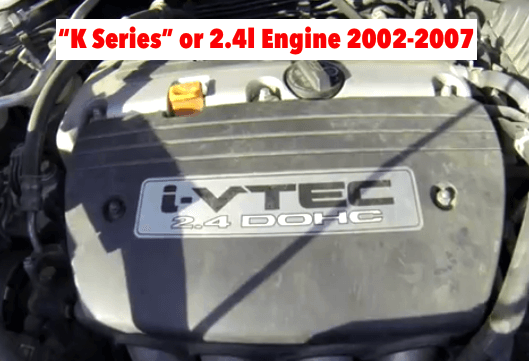
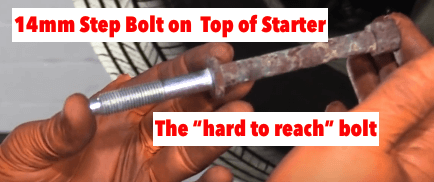
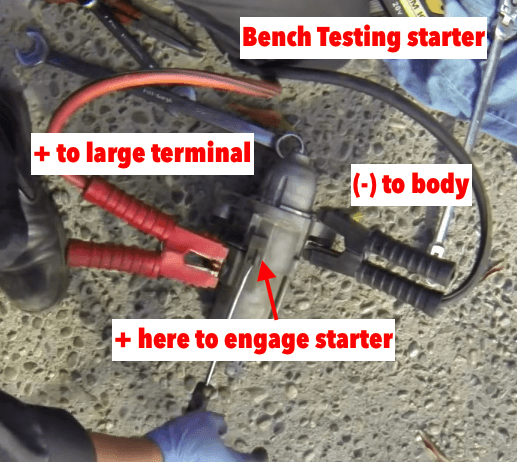
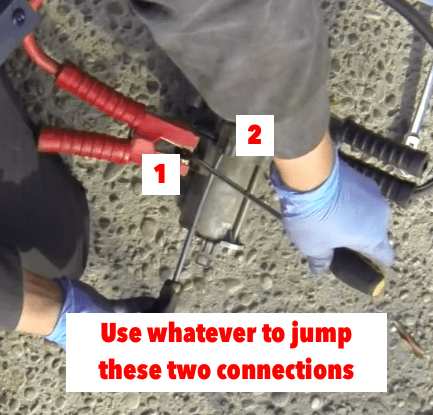 Bench test your old starter and your new starter super easily with jumper cables. Go to +/- on a good 12v battery with jumper cables, then put the (- negative) cable on the starter somewhere to ground it out and with the (+ positive) jumper cable use it to touch both the 12v larger connection and the 12v signal connection at the same time. You should see sparks and either the starter will jump out and engage (be sure to keep a foot on the starter to keep it from jumping around). Or it won’t do anything and you know it is bad!
Bench test your old starter and your new starter super easily with jumper cables. Go to +/- on a good 12v battery with jumper cables, then put the (- negative) cable on the starter somewhere to ground it out and with the (+ positive) jumper cable use it to touch both the 12v larger connection and the 12v signal connection at the same time. You should see sparks and either the starter will jump out and engage (be sure to keep a foot on the starter to keep it from jumping around). Or it won’t do anything and you know it is bad!



